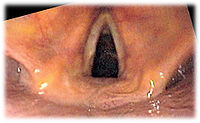
Photo from wikipedia
Objective: Several videolaryngoscopes have been developed for using in difficult airway. We conducted this study to evaluate the performance of McGrath® MAC and King Vision® videolaryngoscopes in a simulated difficult… Click to show full abstract
Objective: Several videolaryngoscopes have been developed for using in difficult airway. We conducted this study to evaluate the performance of McGrath® MAC and King Vision® videolaryngoscopes in a simulated difficult airway. Methods: This prospective, randomised, comparative study was conducted in 140 surgical patients. Anaesthesia was administered as per standard protocol. A cervical collar was applied to simulate a difficult airway. Patients were randomised into 2 groups. In group M (n = 70), laryngoscopy was performed first with King Vision® videolaryngoscope and second time with McGrath® MAC videolaryngoscope and trachea was intubated using the second device, while in group K (n = 70), laryngoscopy was performed first with McGrath® MAC videolaryngoscope and second time with King Vision® videolaryngoscope and trachea was intubated using the second device. The laryngeal view, time taken for optimal laryngeal view, number of intubation attempts, ease of intubation, first attempt intubation success, time to tracheal intubation, haemodynamic parameters, and complications such as airway trauma, if any, were noted. Results: Tracheal intubation was faster with McGrath® MAC (34.89 ± 3.7 seconds) compared to King Vision® videolaryngoscope (43.43 ± 4.3 seconds, P < .001) with comparable first attempt intubation success by 100% vs 97.1%, P = .496, respectively. The laryngeal view obtained with both the devices was comparable but the mean time taken for optimal laryngeal view was significantly longer with King Vision® videolaryngoscope, both in group M (P < .001) and group K (P < .001). Ease of intubation and complications were comparable in the 2 groups. Conclusion: McGrath® MAC videolaryngoscope in comparison to King Vision® videolaryngoscope resulted in a shorter time taken for optimal laryngeal view and time to tracheal intubation with comparable first attempt intubation success.
Journal Title: Turkish Journal of Anaesthesiology and Reanimation
Year Published: 2022
Link to full text (if available)
Share on Social Media: Sign Up to like & get
recommendations!